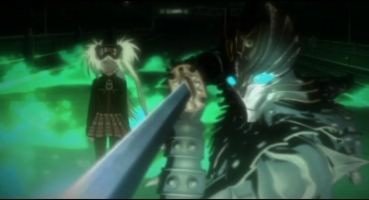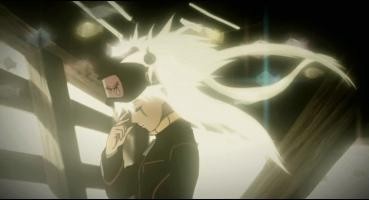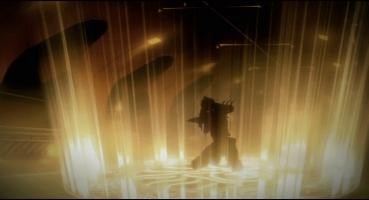|
The
full-length animated feature Karas: The Prophecy (released 24th April) has been hailed as "Batman with a
samurai sword," and features impressive visuals around a
plot that's not so easy to grasp. I'd have to agree with
the "Batman" comment – Karas's setting
is gloomy enough to be Gotham City, and our black-clad hero's
vigilante ethic is much the same as the caped crusader's.
But whether the story is as good as it sounds is another
matter entirely.
Karas is set in a depressing, perpetually-stormy version of Shinjuku,
where youka (demons) exist alongside humans, in the shadows,
where no-one can see them. But just like humans, youkai
get ill too, and their "doctor" is Otoha. By day, he dishes
out medicine to sick demons – by night, he transforms into
the menacing figure of Karas, the youkai's chief protector
against anything that might do them harm.

Lurking
in the background is Eko (Matthew Lillard; Scooby-Doo),
an ex-Karas, who's become disillusioned with the youkai's
peaceful coexistance with humans, and wishes to stir things
up a little. He employs an army of cybernetic youkai called
the Mikura, and his goal is to capture all the youkai in
the world and turn them to his cause. Otoha – with his mentor
Yurine (Piper Perabo; Cheaper By The Dozen) – is
tasked with stopping Eko's plans and saving the world.
During
the course of the story, we meet several smaller players
who've become caught up in Eko and Otoha's conflict: the
X Files-esque detectives Kure and Sagisaka; odd-jobs
girl Hinaru, and enigmatic Mikura-fighter Nue (Jay Hernandez;
Hostel).
There
are several problems with Karas's narrative structure,
not least of which is that this is Part 1 of 2 – the second
part, Karas: The Revelation, follows later in the
year. You would think that because of this, Karas
would have ample time to flesh out all of its characters,
main and supporting – which brings us to the second problem:
it doesn't get around to it. Karas sacrifices character
development for flashy CGI-based action scenes (which I'll
talk about later), leaving the characters as little more
than pawns in a narrative that's dragged in far too many
directions to be truly cohesive.
The
third problem with Karas is the plot itself – it's
almost completely incomprehensible. Most of the plot synopsis
above didn't come from my understanding of the feature;
instead, I had to rely on what I was told in the promotional
material. In fact, when I first started watching Karas,
I saw the first half-hour of it, got bored and switched
it off. It took me a while to muster up the enthusiasm to
finish it off so that I could review it. The feature simply
doesn't explain anything about the plot or the characters
– the viewer is expected to magically "know" what's going
on before he even tunes in. This is not a good storytelling
technique; it's barely tolerable in productions based on
books or comics, and just bad form in original productions
like Karas.

For
all its sins, Karas does know how to do a good battle
scene. Every battle in the feature is presented in full
CGI, and it looks amazing. Rendered mostly in matte-black
tones and thus maintaining a silhouetted effect, Karas transforms
effortlessly between ninja, car and flight modes and clashes
with well-designed Mikura monsters – ranging from a vehicular
monstrosity to an alluring spider-creature. I must applaud
the animation team; this is the most technically-accomplished
CGI production I've seen since Star
Wars: Episode 3. Karas's fighting style seems to
borrow from Super Sentai, with its "cool" poses and
signature maneuvers, but mixes in some of the cinematic
magical techniques common to Japanese console RPGs (such
as the Final Fantasy series).
On
the voicework side of things, Manga's decision to cast three
"big name" Hollywood actors – if you feel comfortable calling
Hernandez, Lillard and Perabo "big" – strikes me as a ittle
pointless. It bothered me in Princess Mononoke, and
it bothers me here. Hernandez comes across as the best of
the three, but Lillard is underused and Perabo is totally
wasted on the emotionless character of Yurine. I respect
that this is a very high-profile release for Manga, and
that they obviously wanted to draw in mainstream sci-fi/action
fans as well as the usual animé/manga crowd, but
they would've done a lot better to have veteran English
voice-actors playing the roles instead.
As
for music, Karas again reminds me of Final Fantasy;
there's a particular "ominous" theme used at least twice
that I'll swear blind has been ripped from Nobuo Uematsu's
scores. The main battle theme features pumped foreign chanting,
a la Matrix impresario Don Davis. And as always,
there's a J-Pop ballad over the ending credits, which is
about as generic as you can get.
To
sum up, Karas is the ultimate triumph of style over substance.
The CGI battle sequences blew me away, but the plot isn't
explained in sufficient-enough detail, and none of the characters
have any depths beyond basic personality type and motives.
Hopefully, the second part of Karas will bind the
story and characters together and go some way towards explaining
why viewers looking for a well-told story would have any
pressing need to watch this.
The
1.85:1 anamorphic picture here is first rate. Colours are
strong and detail is very good – the slightly overexposed
look in some sequences is deliverate and proving common
in recent animé releases.

The
Dolby 2.0 stero mix is a good, but the 5.1 and DTS tracks
are really impressive, with sound coming at you from every
direction in the battle scenes and some thumping bass in
the music and effects. The rears are sometimes very specifically
used, and at one point had me looking over my shoulder at
noises I thought, just for a second, were taking place in
the room.
As
befitting its high-profile release, Manga has stuffed Karas full of extras – the best of which isn't a true "DVD extra",
but a micro-comic included in the packaging. This comic
– produced by Dark Horse in a western, not manga, style
– explains a little about the plot of the feature, and chronicles
Otoha's first meeting with Eko. As a fan of western comics
myself, I found this offering to be very welcome indeed.
On
the first disc, the special features are: a Behind
the Scenes look at the feature's Japanese production
(3:40); wireframe-to-CGI Concept Animation
comparison shots (2:34); interviews with Japanese
Voice-Actors; and sound effects (20:00)
– which, bizarrely, is the longest and most detailed feature
of the lot. Finally, there's the original Japanese trailers
and TV spots for Karas.
Disc
2 takes the Ghost in the Shell turn of including
the DTS audio track for the main feature, and no extras
other than Manga Entertainment's usual bevy of trailers.
In order: the Art of Animé promo; Ghost
in the Shell 2, Ghost in the Shell SAC 2nd Gig, Millennium
Actress, Street Fighter Alpha Generations, Tetsujin 28, Submarine 707R, Tokyo Underground, Heat Guy J and Survive
Style 5+.
|